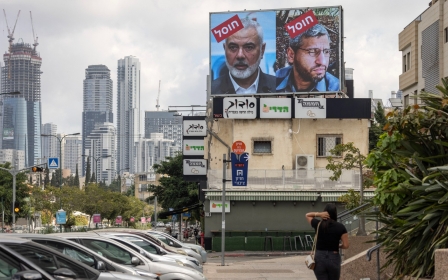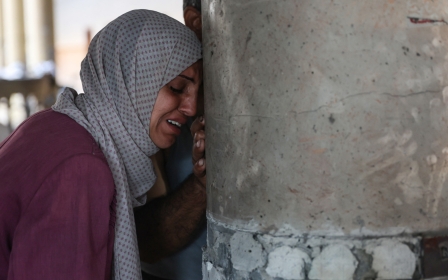Exclusive: Hamas 'categorically rejects' attempts to add Netanyahu’s conditions to Gaza ceasefire proposal

Crunch talks over a ceasefire deal and the release of Israeli captives held in Gaza concluded after a second day in the Qatari capital Doha.
Sources from within the Palestinian movement Hamas told Middle East Eye on Friday that “the Israeli delegation’s primary efforts were to add [Prime Minister Benjamin] Netanyahu’s conditions to be part of [President Joe] Biden’s proposal.”
The sources added that “Hamas categorically rejects Netanyahu’s conditions”.
Commenting on media reports on the latest Doha negotiations, the source said: “All the Israeli and international media leaks portraying the talks as positive, are unfounded and misleading. They [the Israelis] seek to gain time hoping to contain the regional escalation following the assassination of Haniyeh.”
New MEE newsletter: Jerusalem Dispatch
Sign up to get the latest insights and analysis on Israel-Palestine, alongside Turkey Unpacked and other MEE newsletters
Meanwhile, the international mediators - the US, Egypt, and Qatar - issued a joint statement saying the talks “were serious and constructive, and were conducted in a positive atmosphere”.
“The US with support from Egypt and Qatar, presented to both parties a bridging proposal that is consistent with the principles laid out by President Biden on May 31, 2024 and Security Council Resolution No. 2735,” the mediators said in a statement.
“This proposal builds on areas of agreement over the past week, and bridges remaining gaps in the manner that allows for a swift implementation of the deal,” they added.
Hamas, which is not present at the talks but is in close contact with mediators Egypt and Qatar, has maintained that the parties should focus on implementing the ceasefire deal currently on the table.
Israel and Hamas have been engaged in indirect talks since January to negotiate a deal that would end the war on Gaza and facilitate a prisoner exchange between the two sides.
They have gone back and forth over the details of a three-phased outline for the agreement, presented by US, Qatari and Egyptian mediators.
The outline was backed by the Biden administration in May and the UN Security Council in June.
It would see a phased end to the Israeli war on Gaza, the withdrawal of Israeli troops from the strip, and the release of all Israeli captives in exchange for Palestinian prisoners.
The talks, however, were suspended after Ismail Haniyeh, Hamas’ political leader and chief negotiator, was assassinated while visiting Tehran at the end of July, in what the group said was an Israeli strike.
For Hamas, it remains unclear how much Netanyahu is willing to compromise following several additional demands he has introduced in recent weeks.
The major sticking points reportedly include his insistence that Israel will not withdraw from the Gaza-Egypt border region, known as the Philadelphi corridor.
According to documents seen by The New York Times, Netanyahu’s government is also insisting that Palestinians returning to their homes in the north be screened for weapons.
A senior US official told reporters on Friday that the stipulation that no Palestinian carrying arms would be allowed to travel from southern Gaza to the north "is a core provision of the deal".
"We believe, as do the other mediators, that that is a material principle of the deal, and that if anyone is carrying arms from south to north, that would be a violation of the deal," the official said, without discussing whether Washington agreed to the screening of Palestinians.
The official also said that regarding the Philadelphi corridor, the "issue is moving the right way, and I think very consistent with the May 27 text". Israel's stipulation that it would maintain physical control of the corridor was added after its 27 May proposal, according to the New York Times.
Critics of the Netanyahu government, and Biden himself, have said that the prime minister is stalling negotiations and is not interested in a ceasefire or bringing a close to the war because it would end the deeply unpopular leader's political career, as he faces accountability for the 7 October Hamas-led attacks on southern Israel as well as a major corruption trial.
MEE reached out to the White House, the Qatari foreign ministry and Netanyahu’s office for comment but did not receive a response by time of publication.
'Unimaginable situation'
On Thursday, Husam Badran, a top Hamas official, said the group demanded that “any negotiations must be based on a clear plan to implement what was previously agreed.
“Any agreement must achieve a comprehensive ceasefire, a complete withdrawal from Gaza, the return of the displaced and the reconstruction, in addition to a prisoner exchange deal,” he added in a statement.
The talks come as Britain’s foreign secretary, David Lammy, and his French counterpart visited Jerusalem on Friday in the first joint UK-France visit in more than a decade.
Lammy said “the time is now” for a ceasefire deal that would see the release of hostages.
The stakes have risen for a Gaza ceasefire deal after Palestinian health officials said on Thursday that the death toll from Israel’s assault on the enclave had risen to over 40,000 people, with a further 10,000 believed to be trapped under the rubble.
UN rights chief Volker Turk said on average 130 people have been killed every day in Gaza since October, most of them women and children.
“This unimaginable situation is overwhelmingly due to recurring failures by the Israeli Defense Forces to comply with the rules of war,” he said.
The talks also come as tensions continue to rise in the occupied West Bank, where one Palestinian was shot dead late on Thursday after dozens of Israeli settlers rampaged through the village of Jit, attacking locals and torching homes.
Another Palestinian was critically injured, also by live fire, according to Palestinian health authorities and eyewitnesses.
Middle East Eye delivers independent and unrivalled coverage and analysis of the Middle East, North Africa and beyond. To learn more about republishing this content and the associated fees, please fill out this form. More about MEE can be found here.






